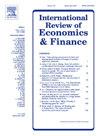Green credit policy and corporate green innovation
IF 5.6
2区 经济学
Q1 BUSINESS, FINANCE
引用次数: 0
Abstract
This study investigates how Green Credit Policy (GCP) influences corporate green innovation (GI) through a comprehensive empirical analysis of Chinese listed firms from 2009 to 2022. Employing a difference-in-differences approach with 29,122 firm-year observations, we document that the implementation of Green Credit Guidelines in 2012 significantly enhances firms’ environmental innovation output, with the causal relationship validated through parallel trends analysis, placebo tests, and propensity score matching. Our investigation reveals two key financial mechanisms: GCP promotes green innovation by alleviating financing constraints and reducing financing costs, creating a supportive environment for environmental technology development. Additionally, digital transformation positively moderates this relationship, indicating that firms with superior digital capabilities respond more effectively to environmental credit policies. Further, a heterogeneity analysis shows that GCP has a stronger impact on state-owned enterprises (SOEs) than non-SOEs, suggesting that government-controlled firms align more closely with national sustainability goals. Industry variations also emerge, with non-heavy polluted industries benefiting more from GCP, while firms in high-pollution sectors experience weaker innovation effects, likely due to compliance-driven financial reallocation rather than proactive sustainability investments. These findings contribute to understanding how financial regulations drive corporate environmental innovation, emphasizing the role of firm characteristics and industry dynamics in shaping policy effectiveness.
绿色信贷政策与企业绿色创新
本文通过对2009 - 2022年中国上市公司的综合实证分析,探讨绿色信贷政策对企业绿色创新的影响。通过对29122家企业年度观察数据的差异中差异分析,我们发现2012年绿色信贷指南的实施显著提高了企业的环境创新产出,并通过平行趋势分析、安慰剂检验和倾向得分匹配验证了因果关系。我们的研究揭示了两个关键的融资机制:GCP通过缓解融资约束和降低融资成本来促进绿色创新,为环境技术发展创造有利的环境。此外,数字化转型正向调节了这一关系,表明具有卓越数字化能力的企业对环境信贷政策的反应更有效。此外,异质性分析表明,GCP对国有企业的影响比非国有企业更大,这表明国有企业与国家可持续发展目标的一致性更强。行业差异也出现了,非重污染行业从GCP中受益更多,而高污染行业的企业创新效应较弱,这可能是由于合规驱动的财务再分配,而不是主动的可持续性投资。这些发现有助于理解金融监管如何推动企业环境创新,强调企业特征和行业动态在塑造政策有效性方面的作用。
本文章由计算机程序翻译,如有差异,请以英文原文为准。
求助全文
约1分钟内获得全文
求助全文
来源期刊
CiteScore
7.30
自引率
2.20%
发文量
253
期刊介绍:
The International Review of Economics & Finance (IREF) is a scholarly journal devoted to the publication of high quality theoretical and empirical articles in all areas of international economics, macroeconomics and financial economics. Contributions that facilitate the communications between the real and the financial sectors of the economy are of particular interest.

 求助内容:
求助内容: 应助结果提醒方式:
应助结果提醒方式:


